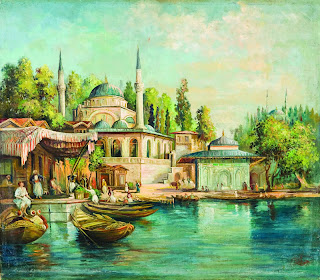Pictures and Painting in Islam

It is only time that we touch a few thorny subjects, and possibly the thorniest of them all is the status of pictures or painting in Islam and Islamic art. The so called ban on pictures opens the door to a myriad of conflicting views and the end result is more than one billion confused people. Some Islamic scholars claim it is banned in any and every form, some claim the ban is on animate objects, some say it is only limited to picturing the prophet, i.e. Mohammad, and some of course believe there is no such restriction at all.
The issue has not come to the attention of the West until Taliban's destruction of an ancient Buddha temple (because it has a picture of Buddha) in Afghanistan in March 2001. After the temple were blown to pieces, the idea that Islam is hostile to painting has emerged in the West, and exacerbated with the Mohammad caricatures or cartoons of last year.
Before we proceed, let us also define what we mean by Islamic art. Sheila S. Brown and Jonathan M. Bloom give a description of Islamic art in their article The Mirage of Islamic Art: Reflections on the study of an Unwieldy Field (2003, College Art Association; full article requires JSTOR access) as follows:
Islamic art is generally held to be "the art made by artists or artisans whose religion was Islam, for patrons who lived in predominantly Muslim lands, or for purposes that are restricted or peculiar to a Muslim population or a Muslim setting." It therefore encompasses much, if not most, of the art produced over fourteen centuries in the "Islamic lands," usually defined as the arid belt covering much of West Asia but stretching from the Atlantic coast of North Africa and Spain on the west to the steppes of Central Asia and the Indian Ocean on the east. These were the lands where Islam spread during the initial conquests in the seventh and eighth centuries C.E. Other regions where Islam flourished in later centuries, such as tropical Africa, eastern Europe, southern Russia, western China, northern India, and southeast Asia, are marginalized by this definition and thereby treated as peripheral to the main story, even though they have huge, and some majority, Muslim populations.
[...]
As an academic discipline, however, the study of Islamic art is normally restricted to the "core" Islamic lands between Egypt and Central Asia from the seventh to the eighteenth century, with occasional forays into Spain, Sicily, and India or later periods.
Now, I have no intention of dumping on you all those contradicting views. Rather, I will point you to Prof. Dr. Silvia Naef's (an expert on Islamic art) excellent book, Bilder und Bilderverbot im Islam. Vom Koran bis zum Karikaturnstreit, where she analyzes them all. If there is one source on the subject, this is it; provided you know German.
However, if you have read this far, you are entitled to my own opinion on the subject. As some of might have guessed, considering the very existence of this very web log, it is very liberal, indeed. First off, there is no such thing as a ban in the Koran. Second, the lack of the Church as an institution lead to many self acclaimed authorities in the early years of the religion, and their effects are unfortunately still dominant. Yet, there is a ban, or sort of, in Islam, which causes all the confusion. Worshipping, seeking help from objects, even ones symbolizing God is forbidden. Many mistakenly believe that the ban is on the objects, but if you carefully reread the phrase, the ban is on the actions, or verbs so to speak. If you worship, seek help, pray to an object (say picture of Mohammad), it is a no no. If you admire, show devotion, find it aesthetically pleasing, express your feelings with it, there is nothing inherently wrong with it.

Of course, my humble contribution will not change anything, how sad! So, let me confuse you all a bit more, instead. To your left, you will find just one example of a painting, miniature as a matter of fact, that single-handedly defies all the misconceptions of the centuries. Taken from Miraj-nama (ascension of Mohammad), we see Gabriel carrying Mohammad over the mountains (Tabriz, 14th century, Sarai Albums, Hazine 2154, folio 42b). Apparently, the artist did see no harm in showing the face of the prophet, surrounded by female angels whose hair were visible without headscarves. Triple Crown!



It is really a unique miniature. Good find.
ReplyDeleteHelmut
yes there is restriction and also for jewish.but it means there is ban to draw exactly,it is free put it in abstraction
ReplyDelete